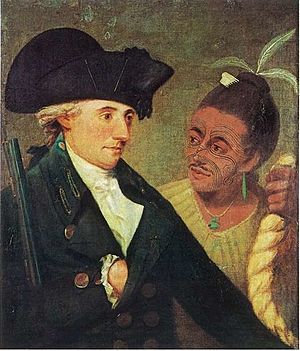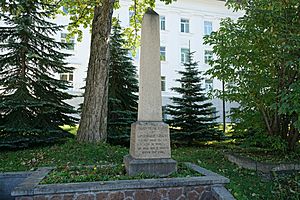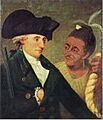Charles Clerke facts for kids
Quick facts for kids
Charles Clerke
|
|
|---|---|

Charles Clerke, by Nathaniel Dance-Holland, 1776
|
|
| Born | 22 August 1741 Essex, England |
| Died | 22 August 1779 (aged 38) Kamchatka, Russia |
| Allegiance | |
| Service/ |
|
| Rank | Captain |
| Commands held | HMS Discovery HMS Resolution |
| Battles/wars | Seven Years' War |
Captain Charles Clerke (born August 22, 1741 – died August 22, 1779) was an officer in the Royal Navy. He went on four exciting voyages of exploration. Three of these trips were with the famous Captain James Cook. When Captain Cook was sadly killed during his third big trip to the Pacific, Clerke took charge. But he later passed away on the same journey from a serious lung illness called tuberculosis.
Contents
Charles Clerke's Early Life and Adventures
Charles Clerke began his studies at the Royal Naval Academy in Portsmouth when he was just 13 years old. He learned all about sailing and naval life.
Serving in the Seven Years' War
During a big conflict called the Seven Years' War, Charles served on two ships: HMS Dorsetshire and HMS Bellona. In 1761, while on HMS Bellona, a part of the ship called the mizzen-top was shot away. Charles was the only person who fell overboard from that spot and survived.
Exploring the Pacific with Captain Byron
In 1764, Charles joined Captain John Byron aboard HMS Dolphin. They went on an expedition to explore the Pacific Ocean. The Dolphin returned in 1766. Their trip around the world took only 22 months, which was the fastest at that time! When he came back, Charles wrote a funny story about meeting giant people in Patagonia.
Voyages with Captain Cook
Charles Clerke's last three voyages were all with the famous explorer Captain James Cook. These were very important trips for mapping the world.
First Voyage with Cook (1768–1771)
Charles started Cook's first voyage on a ship called HM Bark Endeavour. He began as a master's mate, helping the ship's master. Cook saw his talent and promoted him to acting lieutenant in 1771. This rank was officially confirmed later that year.
Second Voyage with Cook (1772–1775)
For Cook's second voyage, Charles was the second lieutenant on HMS Resolution. This trip continued to explore the vast Pacific Ocean.
A Difficult Time Before the Third Voyage
Between Cook's second and third voyages, Charles faced a challenge. He had to spend time in a place called King's Bench, which was a debtor's prison. This happened because one of his brothers owed money, and Charles helped him by taking on the debt. While he was there, he caught tuberculosis, a serious lung illness. This illness would sadly affect him for the rest of his life.
Commanding HMS Discovery and Resolution
For Captain Cook's third expedition, Charles Clerke was given command of his own ship, HMS Discovery. This was a big responsibility.

On February 14, 1779, Captain Cook was killed in a fight with people in Hawaii. After this sad event, Charles Clerke took over as the leader of the entire expedition. He also became the captain of HMS Resolution.
He bravely continued the expedition's mission to explore the northern Pacific coast. They were still looking for a way to sail through the Northwest Passage. The ships then sailed towards the Pacific coast of Siberia.
Charles Clerke's Final Days
Lieutenant James King, who served under Charles, wrote that Charles's illness made him very thin. On August 10, 1779, Charles wrote a letter to Joseph Banks. He explained that the illness he caught in prison had become very serious. He said he hadn't felt well for a single day since then. He was so weak he couldn't even turn himself over in bed. He knew his time was short.
Charles Clerke passed away from tuberculosis on his 38th birthday, August 22, 1779. This happened while the expedition was sailing to Kamchatka from the Bering Strait. He was buried in Kamchatka on August 29, 1779.
After Charles's death, Lieutenant John Gore took command of the expedition. He became the captain of Resolution. James King then became the captain of Discovery. The expedition continued its journey, sailing through China and the Sunda Strait to Cape Town. They finally returned to England in August 1780.
In 1913, the British Admiralty placed a small monument, called an obelisk, in Charles Clerke's honor. It stands in Petropavlovsk-Kamchatsky, Russia, and has an inscription in English.
See also
- European and American voyages of scientific exploration
Images for kids



